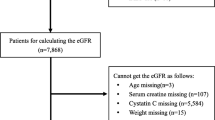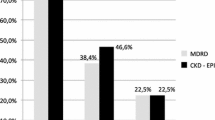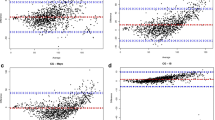Abstract
Introduction
The aim was to assess the predictive value of estimated glomerular filtration rate (eGFR) using two formulas: modification of diet in renal disease (MDRD) and chronic kidney disease epidemiology collaboration (CKD-EPI), in a population with stable coronary artery disease (SCAD) undergoing percutaneous coronary revascularization (PCI).
Methods
The analyzed cohort included 3,141 consecutive patients with SCAD who underwent PCI, between January 2006 and December 2011. Follow-up data were available for 3,123 (99.4 %) patients.
Results
The median follow-up was 1,127 days (interquartile range 566–1,634 days). During the observation period, 330 deaths were reported. In patients with serum creatinine (S-Cr) within normal range, eGFR by CKD-EPI equation predicted long-term outcome more accurately, than eGFR by MDRD formula—continuous Net Reclassification Improvement: 0.296 (95 % CI, 0.08–0.5 p = 0.03). In patients with elevated S-CR, eGFR calculated by both formulae had similar efficacy in assessing death risk. After adjustment for differences in clinical characteristics, both formulae were associated with mortality, but only in patients with elevated S-Cr: eGFR by MDRD (per 10 ml/min/1.73 m2) HR: 0.74 [95 % CI, 0.61–0.89, p = 0.002], eGFR by CKD-EPI (per 10 ml/min/1.73 m2) HR: 0.75 (95 % CI, 0.63–0.89, p = 0.001). After adjustment for covariates, eGFR by CKD-EPI equation did not offer more appropriate categorization of individuals with respect to long-term mortality.
Conclusion
Our results indicate that in multivariable analysis eGFR calculated by MDRD and CKD-EPI equations has similar predictive value. In a population of patients with SCAD and S-Cr within normal range, eGFR calculated by CKD-EPI equation outperforms eGFR calculated by MDRD equation in assessing death risk.

Similar content being viewed by others
References
Coceani M, Carpeggiani C, L’Abbate A (2008) Comparative prognostic value of glomerular filtration rate estimating formulas in ischaemic heart disease. Eur J Cardiovasc Prev Rehabil 15:423–427
Kasai T, Miyauchi K, Kajimoto K, Kubota N, Dohi T, Tsuruta R et al (2011) Prognostic significance of glomerular filtration rate estimated by the Japanese equation among patients who underwent complete coronary revascularization. Hypertens Res 34:378–383
Di Angelantonio E, Chowdhury R, Sarwar N, Aspelund T, Danesh J, Gudnason V (2010) Chronic kidney disease and risk of major cardiovascular disease and non-vascular mortality: prospective population based cohort study. BMJ 341:c4986
Gibson CM, Dumaine RL, Gelfand EV, Murphy SA, Morrow DA, Wiviott SD et al (2004) Association of glomerular filtration rate on presentation with subsequent mortality in non-ST-segment elevation acute coronary syndrome; observations in 13,307 patients in five TIMI trials. Eur Heart J 25:1998–2005
Gruberg L, Weissman NJ, Waksman R, Laird JR, Pinnow EE, Wu H et al (2002) Comparison of outcomes after percutaneous coronary revascularization with stents in patients with and without mild chronic renal insufficiency. Am J Cardiol 89:54–57
Weiner DE, Tabatabai S, Tighiouart H, Elsayed E, Bansal N, Griffith J et al (2006) Cardiovascular outcomes and all-cause mortality: exploring the interaction between CKD and cardiovascular disease. Am J Kidney Dis 48:392–401
Kuchulakanti PK, Torguson R, Chu WW, Canos DA, Rha S, Clavijo L et al (2006) Impact of chronic renal insufficiency on clinical outcomes in patients undergoing percutaneous coronary intervention with sirolimus-eluting stents versus bare metal stents. Am J Cardiol 97:792–797
Best PJM, Berger PB, Davis BR, Grines CL, Sadeghi HM, Williams BA et al (2004) Impact of mild or moderate chronic kidney disease on the frequency of restenosis: results from the PRESTO trial. J Am Coll Cardiol 44:1786–1791
Yazaki Y, Iijima R, Nakamura M, Sugi K (2011) Relationship between renal function stage and clinical outcomes after paclitaxel-eluting stent implantation. J Cardiol 57:61–68
Wiesner R, Edwards E, Freeman R, Harper A, Kim R, Kamath P et al (2003) Model for end-stage liver disease (MELD) and allocation of donor livers. Gastroenterology 124:91–96
Botev R, Mallié J-P, Couchoud C, Schück O, Fauvel J-P, Wetzels JFM et al (2009) Estimating glomerular filtration rate: Cockcroft-Gault and Modification of Diet in Renal Disease formulas compared to renal inulin clearance. Clin J Am Soc Nephrol 4:899–906
K/DOQI (2002) Clinical practice guidelines for chronic kidney disease: evaluation, classification, and stratification. Am J Kidney Dis 39(Suppl 1):S1–S266
Section I (2002) Measurement of renal function, when to refer and when to start dialysis. Nephrol Dial Transplant 17(Suppl 7):7–15
Coresh J, Selvin E, Stevens LA, Manzi J, Kusek JW, Eggers P et al (2007) Prevalence of chronic kidney disease in the United States. JAMA 298:2038–2047
Levey AS, Coresh J, Greene T, Marsh J, Stevens LA, Kusek JW et al (2007) Expressing the Modification of Diet in Renal Disease Study equation for estimating glomerular filtration rate with standardized serum creatinine values. Clin Chem 53:766–772
Levey AS, Stevens LA, Schmid CH, Zhang YL, Castro AF, Feldman HI et al (2009) A new equation to estimate glomerular filtration rate. Ann Intern Med 150:604–612
Bell RM, Rear R, Cunningham J, Dawnay A, Yellon DM (2014) Effect of remote ischaemic conditioning on contrast-induced nephropathy in patients undergoing elective coronary angiography (ERICCIN): rationale and study design of a randomised single-centre, double-blind placebo-controlled trial. Clin Res Cardiol 103(3):203–209. doi:10.1007/s00392-013-0637-3
McCullough PA, Adam A, Becker CR, Davidson C, Lameire N, Stacul F et al (2006) Epidemiology and prognostic implications of contrast-induced nephropathy. Am J Cardiol 98:5K–13K
Estimating Glomerular Filtration Rate (GFR)—National Kidney Disease Education Program (NKDEP). http://nkdep.nih.gov/lab-evaluation/gfr/estimating.shtml. Accessed 20 Jan 2014
Kirsztajn GM, Suassuna JHR, Bastos MG (2009) Dividing stage 3 of chronic kidney disease (CKD): 3A and 3B. Kidney Int 76:462–463 (author reply 463–464)
Stekhoven DJ, Bühlmann P (2012) MissForest—non-parametric missing value imputation for mixed-type data. Bioinformatics 28:112–118
Waljee AK, Mukherjee A, Singal AG, Zhang Y, Warren J, Balis U, Marrero J, Zhu J, Higgins PD (2013) Comparison of imputation methods for missing laboratory data in medicine. BMJ Open 3(8). doi:10.1136/bmjopen-2013-002847
Stekhoven DJ (2013) MissForest: nonparametric missing value imputation using random forest. R package version. 1.4
Newson RB (2010) Comparing the predictive power of survival models using Harrell’ s C or Somers’. Stata J 3:339–358
Cook NR (2007) Use and misuse of the receiver operating characteristic curve in risk prediction. Circulation 115:928–935
Pencina MJ, D’Agostino RB, Steyerberg EW (2011) Extensions of net reclassification improvement calculations to measure usefulness of new biomarkers. Stat Med 30:11–21
Uno H, Tian L, Cai T, Kohane IS, Wei LJ (2013) A unified inference procedure for a class of measures to assess improvement in risk prediction systems with survival data. Stat Med 32:2430–2442
Pickering JW, Endre ZH (2012) New metrics for assessing diagnostic potential of candidate biomarkers. Clin J Am Soc Nephrol 7:1355–1364
R Core Team (2013) R: a language and environment for statistical computing
Choi JS, Kim CS, Park JW, Bae EH, Ma SK, Jeong MH et al (2012) Renal dysfunction as a risk factor for painless myocardial infarction: results from Korea Acute Myocardial Infarction Registry. Clin Res Cardiol 101:795–803
Ndrepepa G, Neumann F-J, Cassese S, Fusaro M, Ott I, Schulz S et al (2014) Incidence and impact on prognosis of bleeding during percutaneous coronary interventions in patients with chronic kidney disease. Clin Res Cardiol 103:49–56
Manjunath G, Tighiouart H, Ibrahim H, MacLeod B, Salem DN, Griffith JL et al (2003) Level of kidney function as a risk factor for atherosclerotic cardiovascular outcomes in the community. J Am Coll Cardiol 41:47–55
Go AS, Chertow GM, Fan D, McCulloch CE, Hsu C (2004) Chronic kidney disease and the risks of death, cardiovascular events, and hospitalization. N Engl J Med 351:1296–1305
Weiner DE, Tighiouart H, Amin MG, Stark PC, MacLeod B, Griffith JL et al (2004) Chronic kidney disease as a risk factor for cardiovascular disease and all-cause mortality: a pooled analysis of community-based studies. J Am Soc Nephrol 15:1307–1315
Shlipak MG, Fried LF, Crump C, Bleyer AJ, Manolio TA, Tracy RP et al (2003) Elevations of inflammatory and procoagulant biomarkers in elderly persons with renal insufficiency. Circulation 107:87–92
Keller C, Katz R, Cushman M, Fried LF, Shlipak M (2008) Association of kidney function with inflammatory and procoagulant markers in a diverse cohort: a cross-sectional analysis from the Multi-Ethnic Study of Atherosclerosis (MESA). BMC Nephrol 9:9
Bramlage P, Cuneo A, Zeymer U, Hochadel M, Richardt G, Silber S et al (2013) Prognosis of patients with atrial fibrillation undergoing percutaneous coronary intervention receiving drug eluting stents. Clin Res Cardiol 102:289–297
Arnaudis B, Lairez O, Escamilla R, Fouilloux A, Fournier P, Monteil B et al (2012) Impact of chronic obstructive pulmonary disease severity on symptoms and prognosis in patients with systolic heart failure. Clin Res Cardiol 101:717–726
Kuznik A, Mardekian J, Tarasenko L (2013) Evaluation of cardiovascular disease burden and therapeutic goal attainment in US adults with chronic kidney disease: an analysis of national health and nutritional examination survey data, 2001–2010. BMC Nephrol 14:132
Ndrepepa G, Tada T, Fusaro M, Cassese S, King L, Hadamitzky M et al (2012) Association of coronary atherosclerotic burden with clinical presentation and prognosis in patients with stable and unstable coronary artery disease. Clin Res Cardiol 101:1003–1011
Botev R, Mallié J-P (2008) Reporting the eGFR and its implication for CKD diagnosis. Clin J Am Soc Nephrol 3:1606–1607
Matsushita K, Selvin E, Bash LD, Astor BC, Coresh J (2010) Risk implications of the new CKD epidemiology collaboration (CKD-EPI) equation compared with the MDRD Study equation for estimated GFR: the Atherosclerosis Risk in Communities (ARIC) Study. Am J Kidney Dis 55:648–659
Skali H, Uno H, Levey AS, Inker LA, Pfeffer MA, Solomon SD (2011) Prognostic assessment of estimated glomerular filtration rate by the new chronic kidney disease epidemiology collaboration equation in comparison with the Modification of Diet in Renal Disease Study equation. Am Heart J 162:548–554
Ohsawa M, Tanno K, Itai K, Turin TC, Okamura T, Ogawa A et al (2013) Comparison of predictability of future cardiovascular events between chronic kidney disease (CKD) stage based on CKD epidemiology collaboration equation and that based on modification of diet in renal disease equation in the Japanese general population–I. Circ J 77:1315–1325
Shlipak MG, Matsushita K, Ärnlöv J, Inker LA, Katz R, Polkinghorne KR et al (2013) Cystatin C versus creatinine in determining risk based on kidney function. N Engl J Med 369:932–943
Acknowledgment
The creation of the database of patients with stable coronary artery disease used in this study was supported by the National Science Center—Dec-2011/01/D/NZ5/04387. Study was approved by ethics committee at district chamber of physicians.
Conflict of interest
None declared.
Author information
Authors and Affiliations
Corresponding author
Rights and permissions
About this article
Cite this article
Osadnik, T., Wasilewski, J., Lekston, A. et al. Comparison of modification of diet in renal disease and chronic kidney disease epidemiology collaboration formulas in predicting long-term outcomes in patients undergoing stent implantation due to stable coronary artery disease. Clin Res Cardiol 103, 569–576 (2014). https://doi.org/10.1007/s00392-014-0687-1
Received:
Accepted:
Published:
Issue Date:
DOI: https://doi.org/10.1007/s00392-014-0687-1




